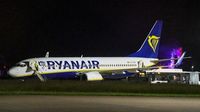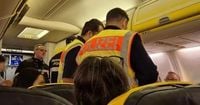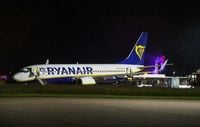On the evening of June 4, 2025, a Ryanair flight from Berlin to Milan was forced into an emergency landing at Memmingen Airport in Bavaria, Germany, after encountering severe turbulence that left nine people injured, including a two-year-old child. The Boeing 737-800 aircraft, registered EI-EKN, was carrying 179 passengers and six crew members when violent storms over southern Germany caused the plane to be violently buffeted, prompting the pilot to divert the flight for safety reasons.
The turbulence struck around 8:30 p.m. local time while the aircraft was cruising over southern Germany. Passengers described chaotic scenes onboard, with some being thrown against the ceiling and others caught unprepared, including a mother and her baby who were reportedly in the toilet at the time. One passenger told German newspaper Bild, "I've never been scared before, but in that moment, I thought the plane was going to break apart or roll over." Others recalled the plane suddenly tilting sharply amid the violent shaking.
Emergency services were on standby at Memmingen Airport, meeting the plane upon landing at 8:44 p.m. Local authorities confirmed that nine people were injured—eight passengers and one crew member. Three individuals required hospital treatment: a woman with a head injury, her bruised two-year-old child, and another passenger who suffered back pain. The others received outpatient care at the scene. Despite the injuries, the Boeing 737-800 landed safely without further incident.
Due to safety concerns stemming from the weather-related damage, the aircraft was grounded and not permitted to continue its journey to Milan. Ryanair arranged ground transportation for all passengers, dispatching buses to cover the approximately 380-kilometer (236-mile) trip to Milan overnight. A replacement flight was scheduled for the following morning to complete the journey. The airline issued a statement apologizing to those affected, saying, "FR8 from Berlin to Milan on 4th June diverted to Memmingen after experiencing some air turbulence. The captain called ahead for medical assistance and the aircraft landed normally. To get passengers to their final destination as quickly as possible, we arranged for alternative transport from Memmingen to Milan that night, as well as a replacement flight this morning."
Severe weather conditions played a central role in the incident. Southern Germany was battered by intense storms on the same evening, with the German Weather Service (DWD) issuing storm warnings that extended through June 5. The storms featured hail, strong winds, and localized flooding. In the city of Ulm, located in the neighboring state of Baden-Württemberg, roofs were torn off multiple row houses in the Donaustetten district, an event likely caused by a small tornado or waterspout. Fortunately, no injuries were reported in that area.
Emergency services were stretched responding to numerous weather-related incidents across Bavaria and Baden-Württemberg, including fallen trees blocking roads and flooded basements. Firefighters and police handled approximately 200 calls in Bavaria alone, while neighboring Czech Republic saw nearly 500 deployments to clear roads and pump water from flooded areas. A 61-year-old cyclist near Ingolstadt was injured after colliding with a toppled tree during the storms.
Experts analyzing flight data suggested that the Ryanair aircraft encountered a "supercell" thunderstorm—a highly dangerous rotating storm system capable of producing tornado-like winds spanning up to 30 miles. Flightradar24 data showed an abrupt course change as the pilot diverted to Memmingen, bypassing the originally planned landing at Munich Airport, which was deemed impossible due to the severe weather. The German Weather Service continues to investigate the meteorological conditions that led to this extreme event.
Ryanair's emergency landing is not an isolated case in recent months. Earlier in 2025, a United Airlines flight from San Francisco to Singapore experienced severe turbulence over the Philippines on March 27, injuring five people onboard. Alaska Airlines flight AS700 encountered similar conditions near Phoenix on December 26, 2024, requiring medical attention for several crew members and one passenger. American Airlines flight AA168 from Tokyo to New York also reported crew injuries due to turbulence on November 15, 2024.
Turbulence remains a significant hazard in commercial aviation, caused by a variety of atmospheric phenomena. Mountain-induced turbulence arises when air masses are forced over peaks, creating waves that can become chaotic. Jet streams, fast-moving air currents near the poles, generate shear zones where sudden changes in wind speed create rough air. Storm-generated turbulence, like that encountered by Ryanair, often extends far beyond the storm's visible clouds, making it difficult for pilots to anticipate. Clear air turbulence, which occurs without visual cues like clouds or precipitation, poses an especially tricky challenge for flight crews since it cannot be detected by conventional weather radar.
Passengers caught in turbulence can experience sudden jolts and altitude changes, which, if not seated with seatbelts fastened, can cause injuries. In the Ryanair incident, some passengers reportedly were not wearing seatbelts when the turbulence struck, exacerbating the risk of harm. Aviation authorities continuously study such events to improve forecasting and pilot training, aiming to minimize risks and enhance passenger safety.
As southern Germany recovers from the storm's aftermath, with damaged homes and disrupted transport, the Ryanair emergency landing stands as a stark reminder of the unpredictable power of nature and the resilience required in modern air travel. Passengers affected by the incident have expressed relief that the plane landed safely despite the terrifying ordeal, while emergency responders and airline personnel worked swiftly to provide care and ensure onward travel.



